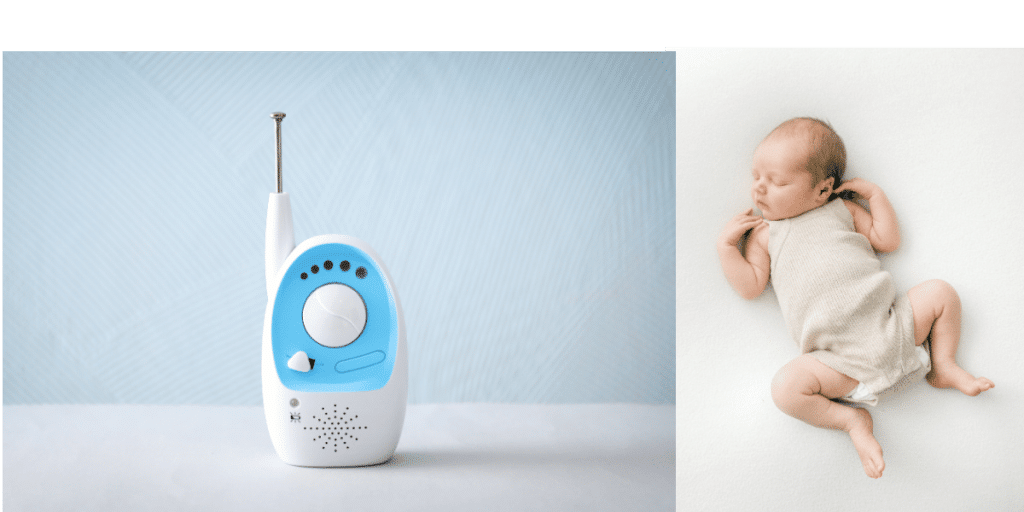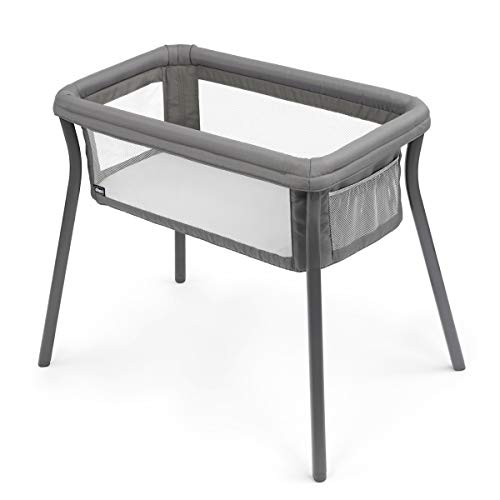Safe Sleep for Newborns: Complete 2025 Guide (Pediatrician-Approved Tips)
Did you know that 3,400 babies in the United States die suddenly and unexpectedly each year during sleep? As a parent, creating a safe sleep environment isn’t just about comfort – it’s about peace of mind! As a nurse practitioner I’ve researched and collaborated with pediatricians and safety experts to bring you the most up-to-date guide on safe sleep for newborns. Let’s dive into everything you need to know to help your little one sleep soundly and safely!
For a comprehensive look at newborn sleep 0-12 months, check out my Newborn Sleep Blueprint ebook available here.

Safe Sleep Guidelines for Infants: Current AAP Recommendations
Core Safe Sleep Recommendations
Sleep Position & Environment
- Place infant on their back for every sleep (naps and nighttime)
- Use a firm, flat sleep surface with no incline
- Sleep surface should meet CPSC safety standards
- No additional bedding or soft objects in sleep space:
- No blankets, pillows, bumper pads, or toys
- No positioners or wedges
- No weighted sleepsacks or swaddles
- Only dress baby in sleep clothing designed for sleep (e.g., wearable blankets)
- Swaddling should stop when baby shows signs of rolling (before 4 months)
- Check this link for the Best Safe Sleep Products for Infants
Room-Sharing vs. Bed-Sharing
Room-Sharing (Recommended)
- Infant should sleep in parents’ room for at least first 6 months, ideally first year
- Place crib, bassinet, or portable crib close to parent’s bed
- This arrangement can:
- Decrease SIDS risk by up to 50%
- Facilitate feeding and monitoring
- Not interfere with infant sleep quality
Bed-Sharing (Not Recommended)
- AAP advises against bed-sharing due to increased SIDS risk
- Especially dangerous if:
- Baby is under 4 months
- Parent is overtired
- Parent uses sedating medications
- Parent smokes or has consumed alcohol
- Soft bedding is present
- Multiple people in bed
- Non-parent bed-sharing
Temperature and Environment
Optimal Settings
- Room temperature: 68-72°F (20-22.2°C)
- Humidity: 30-50%
- Ensure good ventilation
- Signs of overheating:
- Sweating
- Chest feels hot
- Flushed cheeks
Clothing Guidelines
- Use TOG-appropriate sleep clothing based on room temperature
- General rule: dress baby in one additional layer than what’s comfortable for an adult
- Avoid over-bundling
Common Myths Debunked
Myth 1: Side sleeping is okay
Reality: Back sleeping is the only safe position. Side-sleeping can lead to rolling onto stomach.
Myth 2: Babies need extra warmth while sleeping
Reality: Overheating increases SIDS risk. Light layers are safer.
Myth 3: Bed-sharing is safe if done carefully
Reality: Even with precautions, bed-sharing carries risks. Room-sharing without bed-sharing is safest.
Myth 4: Sleep positioners prevent SIDS
Reality: Sleep positioners are dangerous and increase suffocation risk. They are not recommended by AAP.
Myth 5: Back sleeping increases choking risk
Reality: Back sleeping does not increase choking risk; anatomy and gag reflex protect airways better in back position.
Additional Safety Measures
- Regular prenatal care
- Breastfeeding when possible
- Pacifier use at sleep time (after breastfeeding is established)
- Avoid smoke exposure
- Regular well-baby check-ups
- Keep up with immunizations
- Supervised tummy time when awake
When to Contact Healthcare Provider
- If infant has difficulty maintaining back position due to medical condition
- Questions about specific sleep products
- Concerns about infant’s sleep patterns
- Signs of sleep-related breathing problems
Note: These guidelines reflect current AAP recommendations as of April 2024. Always consult with your pediatrician for personalized advice and updates.
- ABC’s of safe sleep: Alone, Back, Crib
- Latest AAP recommendations and updates
- Room-sharing vs. bed-sharing guidelines
- Temperature monitoring and optimal room settings
- Common myths debunked with scientific evidence
Setting Up a Safe Sleep Environment
Crib Safety Standards & Certification Requirements
- Must meet current CPSC (Consumer Product Safety Commission) standards
- Slats no more than 2 3/8 inches apart
- No drop-side rails (banned since 2011)
- Look for JPMA (Juvenile Products Manufacturers Association) certification
- Hardware should be firmly secured with no loose components
- No cracked or splintered wood
Mattress Requirements
- Firm, flat surface with no incline
- Must fit snugly with no gaps (less than two fingers’ width between mattress and crib)
- Should meet federal flammability standards
- Covered by tight-fitting sheet only
- Replace if sagging or compressed
- Avoid second-hand mattresses
Safe Room Positioning
- Place crib away from windows (minimum 2 feet)
- No cords within 3 feet of crib (including monitor cords)
- Away from heaters and air vents
- No furniture that could be climbed near crib
- Secure all wall hangings
- Install window guards if windows are nearby
Essential Monitoring Equipment to Ensure Safe Sleep for Newborns
- Audio/video baby monitor with secure connection
- Room thermometer
- Optional: breathing/movement monitor (if recommended by healthcare provider)
- Smoke and carbon monoxide detectors in room
Items to Keep Out of Sleep Space
- Pillows and cushions
- Loose bedding, including blankets
- Bumper pads (even “breathable” ones)
- Stuffed animals and toys
- Sleep positioners or wedges
- Electrical cords
- Window blind cords
- Mobiles that can be reached
- Any items smaller than a credit card
Regular Safety Checks
- Weekly inspection of crib hardware
- Monthly full safety assessment
- Immediate check after any household changes
- Regular cleaning and sanitizing schedule
Note: Always verify current safety standards with CPSC and AAP as guidelines may update. Consult manufacturer instructions for specific product safety requirements.
Safe Sleep Products Worth Your Investment
- Safety-certified cribs and bassinets
- Breathable mattresses
- SNOO vs. traditional bassinets debate
- Wearable monitors
- Temperature and humidity gauges
- See this link to my full guide to safe sleep product recommendations
Signs Your Baby is Sleeping Safely
Normal Breathing Patterns
Typical Patterns
- Regular, rhythmic breathing (30-60 breaths per minute)
- Brief pauses (2-6 seconds) are normal
- Occasional sighs or grunts
- Nostrils moving slightly with each breath
- Visible gentle chest movements
Normal Sleep Cycles
- Periodic breathing (alternating rapid/slow breathing)
- Brief movement during sleep transitions
- Light sleep includes some movement
- Deep sleep shows steady breathing
Proper Sleep Position Indicators
Safe Positioning Signs
- Back position maintained
- Head centered, not turned sharply
- Arms free to move
- Legs able to kick freely
- No slumping or sliding
Position Monitoring
- Face visible and uncovered
- Chin not tucked to chest
- Neck straight, not twisted
- Shoulders flat against mattress
- No rolling against crib sides
Temperature Assessment
Proper Temperature Signs
- Chest feels warm, not hot
- Back of neck comfortable to touch
- No sweating
- Normal skin color
- Comfortable to touch (not cold)
Room Environment
- Temperature: 68-72°F (20-22.2°C)
- No direct heating/cooling on baby
- Appropriate clothing for conditions
- No overheating signs
Warning Signs Requiring Attention
Immediate Concerns
- Color changes (bluish, pale, or mottled)
- Difficulty breathing or gasping
- Excessive sweating
- Lethargy or difficulty waking
- Unusual crying or distress
Concerning Patterns
- Regular sleep position changes (under 4 months)
- Persistent head-turning to one side
- Frequent startling
- Excessive drowsiness
- Changes in typical sleep behavior
When to Contact Pediatrician
Urgent Situations
- Breathing pauses longer than 10 seconds
- Skin color changes
- Temperature concerns
- Unusual movements or positions
- Difficulty waking
Non-Urgent But Important
- Changes in sleep patterns
- Position maintenance issues
- Temperature regulation concerns
- Persistent sleep difficulties
- Questions about development
Monitoring Best Practices
- Regular visual checks
- Use of appropriate monitoring devices
- Documentation of concerns
- Photo/video of questionable positions
- Track patterns of concern
Note: This guide reflects general indicators. Always follow your pediatrician’s specific guidance, especially for premature infants or those with medical conditions.
Common Safe Sleep Mistakes to Avoid
Unsafe Swaddling Practices
Critical Errors
- Swaddling too tightly around hips
- Leaving arms free while torso is swaddled
- Continuing to swaddle after rolling starts
- Using loose blankets for swaddling
Proper Technique
- Allow hip flexibility
- Ensure chest isn’t compressed
- Stop swaddling at first rolling signs
- Use proper sleep sacks/swaddles
- Monitor for signs of overheating

Hazardous Sleep Accessories
Dangerous Items
- Crib bumpers (including “breathable” ones)
- Sleep positioners and wedges
- Weighted sleepwear or blankets
- Car seats/swings for routine sleep
- Loungers and nursing pillows
Unsafe Products
- Drop-side cribs (banned)
- Inclined sleepers
- Non-certified sleep products
- After-market mattress covers
- Modified or altered sleep items
Environmental Hazards
Room Risks
- Incorrect room temperature
- Dangling cords or wires
- Unsecured furniture
- Window blind cords
- Direct air flow on infant
Bedding Hazards
- Soft or loose bedding
- Decorative pillows
- Stuffed animals
- Extra mattress padding
- Crib tents or covers
Current Product Recalls
Major Categories
- Inclined sleepers
- Sleep positioners
- Certain portable cribs
- Specific swaddle products
- Modified bassinet accessories
Recent Actions
- Rock ‘n Play type products
- Dock-a-Tot type items
- Certain sleep sacks
- Specific crib models
- Popular lounger products
Outdated Practices to Eliminate
Obsolete Methods
- Stomach sleeping
- Side positioning
- Crib bumper use
- Sleep positioner use
- Blanket swaddling
Disproven Approaches
- “Sleep training” before 4 months
- Putting cereal in bottles
- Using positioning devices
- Overdressing for sleep
- Using home sleep monitors without medical need
Prevention Strategies
Best Practices
- Regular safety checks
- Product registration
- Recall monitoring
- Updated pediatric guidance
- Staff/caregiver training
Safety Updates
- Follow AAP guidelines
- Check CPSC website
- Register baby products
- Update childcare providers
- Regular safety assessments
Note: Product recalls and safety guidelines update frequently. Always verify current safety standards and check for recent recalls through CPSC.gov.
Creating a safe sleep environment for your newborn doesn’t have to be overwhelming! By following these updated 2024 guidelines and investing in the right safety measures, you can rest easier knowing your baby is sleeping securely. Remember, when in doubt, always consult with your pediatrician about your specific situation. Sweet dreams to you and your little one!




















